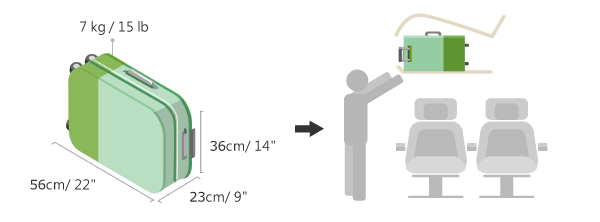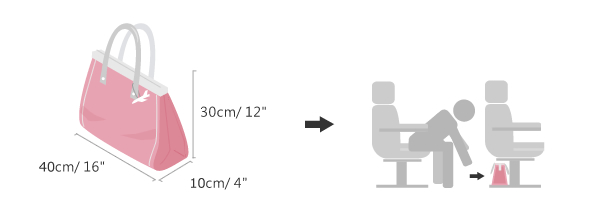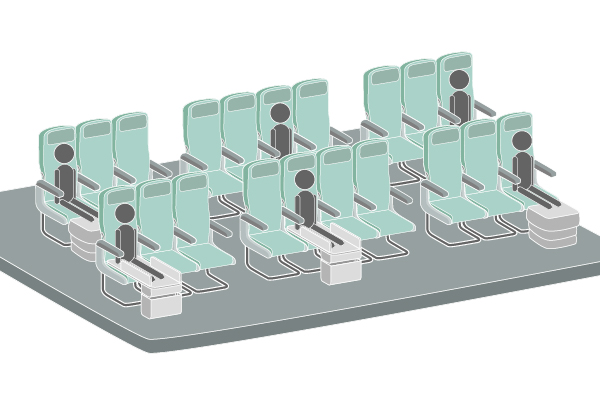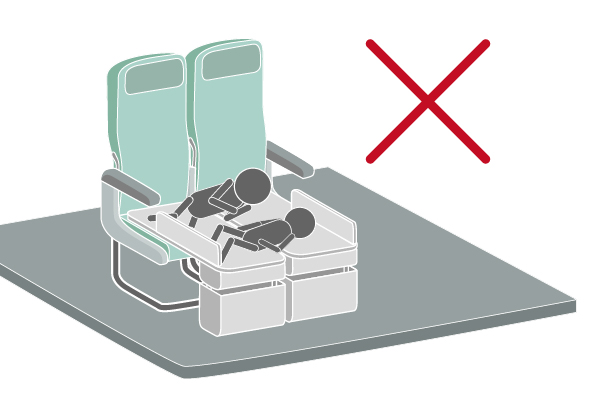Baggage Information
Carry-on Baggage
- Royal Laurel/Premium Laurel/Business Class passengers are allowed to carry two pieces of hand-carry baggage and each piece cannot exceed 7kg/15lbs. Premium Economy/Economy Class passengers are permitted to carry one piece weighing 7kg/15lbs carry-on baggage.
- The maximum dimensions for each piece of hand-carry baggage are 23 × 36 × 56cm / 9 × 14 × 22in or a total of 115cm/45in (personal items are not included in this range). Please note that some carry-on baggage, such as chubby boxes or sports bags, although their total dimensions do not exceed 115 cm/45in, may not fit in the overhead cabin storage due to their excessive depth. We request that you consider checking them instead.
- Rideable smart suitcases with a total weight exceed 7kg/15lbs or over the maximum carry-on size limit must be checked in. Whether as carry-on or checked baggage, these suitcases must comply with lithium battery regulations, please refer to Flight Information - Restrictions for more details.
- For your convenience, a measurement Test Unit is available at either the check-in counter or boarding lounge to help you to determine whether your baggage meets these requirements.

Carry-On Baggage Checks
During check-in, if your carry-on baggage exceeds the limit, we will ask you to check it. Before boarding, we will recheck passengers' carry-on baggage; if it exceeds the limit, it will be checked at the boarding gate. If combined with checked baggage, exceeding your baggage allowance may incur extra fees. Otherwise, we reserve the right to refuse transportation of that baggage. We appreciate your understanding.
- For the safety of passengers and our staff in the cabin, please adhere to the weight and size limits for carry-on baggage, reducing the risk of injuries due to items falling from overhead bins.
- Airport security regulations vary, and some airports may have stricter limits on the number of carry-on items. Check local airport regulations to avoid inconvenience during your journey.
- Even if your carry-on meets weight and size requirements, if cabin space is insufficient, we may check your baggage. Thank you for your cooperation.
- For the safety and comfort of you and fellow passengers, we reserve the right to decide whether any baggage can be carried onboard or must be checked.
- If you wish to carry lighters and power banks, follow regulations. Lighters are allowed in carry-on (some countries prohibit entry), while power banks must be carried in hand baggage. Refer to Flight Information - Restrictions for details.
Please stow your carry-on baggage properly
- Carry-on baggage should be stowed in the shared overhead bin or underneath the seat in front of you. You can stow small, personal items under the seat in front of you and larger bags in the overhead bins.
- Carry-on baggage in overhead bins must adhere to safety principles, allowing crew members to easily close the bin doors. Carry-on baggage should not fall from overhead bins when doors are opened.
- Under-seat carry-on baggage must be secured with front and side blocks to prevent sliding into the aisle. Carry-on baggage should not obstruct passenger movement in the aisle.
- Carry-on baggage must not be placed on passengers’ laps during takeoff and landing.
- The aircraft’s closet is not suitable for stowing passenger baggage.
- Secure your valuables and keep them in sight during the journey, and double-check your belongings upon disembarking to avoid any mix-ups.
In addition to free hand-carry baggage, each passenger may carry one personal item for all classes with a dimension 40 x 30 x 10cm /16 x 12 x 4in or total linear dimensions of 80cm/32in or an item of similar size (subject to local country-specific restrictions, if any). These dimensions include wheels, handles, and side pockets. If your item exceeds the total dimension of 80cm/32in, it will be counted as part of your standard hand-carry baggage allowance. You will then be required to check-in either the hand-carry bag or the personal item.
- a laptop computer*
- a purse
- a small backpack
- a briefcase
- a camera case
- rain gear (umbrella, raincoat)
- a limited amount of duty-free merchandise
*A laptop in a thin satchel-style laptop bag is considered to be a personal item. A laptop in a larger laptop bag will be counted as part of a guest’s hand-carry allowance.

The above items should be safely stowed in the closed overhead bin or under the seat. If you put your free personal item in the seat pocket, it should be within the vertical line from the seat back and under no circumstances can it protrude into the aisle. Passengers are permitted to place small bags on their shoulders or waists after fastening seat belts.
Using small, lightweight portable electronic devices without medical purpose onboard, such as personal air-purifying devices and personal humidifiers, shall follow the restrictions below
- Comply with the carry-on baggage dimension and weight limits and regulations governing the use of portable electronic devices.
- Vapor or incense emitted from electronic devices is strictly prohibited.
Please note that you are not permitted to attach any unapproved device to any part of your seat or any other part of the aircraft such as knee defenders and seat belt extensions.
Items specially permitted in the cabin for specific purposes. These special items should be properly stowed in the shared overhead bin or under the seat in front of you. If they exceed the carry-on baggage regulations, they must be carried as checked baggage.
- One infant's carrying basket or fully collapsible stroller, pushchair, car seat, or CARES harness.
- An infant's necessity items such as diapers, feeding bottles, and food for consumption during the flight cannot exceed 5kg when carried on board.
- Walking stick, crutches, braces, prosthetic device or assistive devices.
- Medicine/medical equipment or supplies.
- Sculptures/urns: These items are accepted in the cabin and should be properly stowed in the shared overhead bin or under the seat in front of you to avoid from sliding or falling. However, you may also pre-book the cabin baggage service to buy extra seat for them. For more information, please refer to Regulation for Cabin Baggage
- Musical instruments: Each passenger is allowed to bring one small musical instrument onboard. Its total dimensions, including the case, should not exceed 125cm (49in), and the weight must be under 7kg (15lbs). For more information, please refer to Regulation for Musical Instruments
Passengers carrying travel gadgets including Bedbox, Fly-Tot, Plane Pal, or other similar products should comply with the regulations below
- Must not be used during the aircraft take-off, landing, or taxiing.
- Must not be used on the aisle and exit seats onboard.
- Must not cause damage to any facility or personnel onboard the aircraft.
- Must not affect the convenience and comfort of other passengers. For example, impede the reclining range of the seat in front.
- If there is any concern that the Bedbox may make other passengers’ movements inconvenient, such Bedbox can only be used on window seats (ex. A/K) or the inner seats of the center row between two aisles (ex. E/F). Passengers need to inform reservation staff to pre-arrange suitable seats if they want to use the products onboard.

- The restriction of quantity, size, weight, and stowing location shall be in compliance with hand-carry baggage regulations.
- Whenever the fasten seat belt sign turns ON during the flight, or a cabin crew member instructs you to do so, passengers must follow the safety regulations below
- For children of two years old and up, the accompanying adult must ensure the child has a securely fastened seat belt.
- For infants (not yet two years old) with child fare ticket, the accompanying adult must hold the infant to prevent injuries.
- Utilizing two or more Bedboxes side-by-side across the seats in the same row to lie down is not permitted.

- Passengers must read the manufacturer’s instructions, and follow EVA regulations to ensure safety for Bedbox users.
